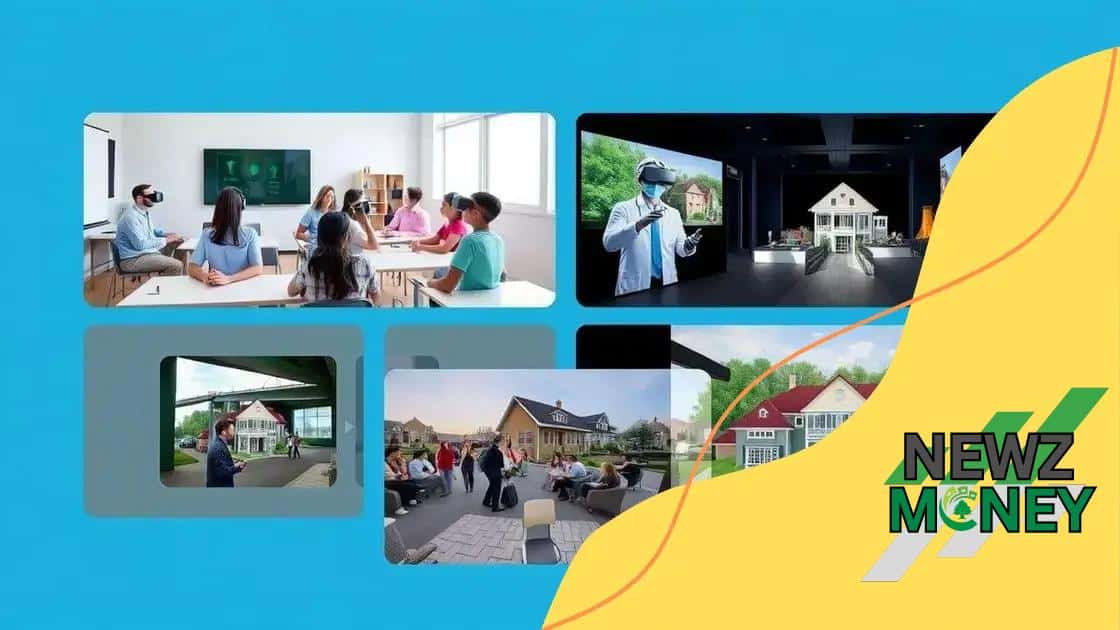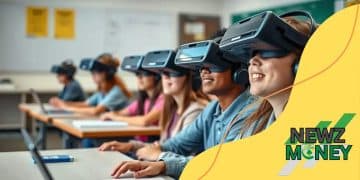Virtual reality in enhancing STEM education

Virtual reality enhances STEM education by providing immersive learning experiences, improving engagement, facilitating personalized education, and enabling collaboration among students, thus preparing them for future challenges.
Virtual reality in enhancing STEM education opens up new avenues for learning, making complex subjects engaging and interactive. Imagine exploring the depths of the ocean or the vastness of space, all from your classroom! This article dives into how VR is transforming educational experiences.
Understanding the impact of virtual reality in STEM
Understanding the impact of virtual reality in STEM education is crucial for teachers, students, and parents alike. With VR technology, students are no longer limited to textbooks and lectures. They can explore complex scientific concepts and engage with subjects like never before.
One key area that shows the benefits of VR in STEM is in science education. The ability to experience scientific phenomena firsthand, such as molecular structures or astronomical events, enables deeper understanding. By stepping into a virtual lab, students can conduct experiments safely and repeatedly, enhancing their learning outcomes.
Benefits of VR in STEM Education
Here are some notable advantages of using virtual reality in the classroom:
- Immersive learning experiences that stimulate interest.
- Improved retention of information through interactive simulations.
- Opportunities for collaboration in a virtual space.
- Personalized learning that caters to individual student needs.
Furthermore, virtual reality can play a significant role in mathematics education. Visualizing complex equations and geometric concepts helps students grasp challenging material. For instance, VR tools can simulate three-dimensional shapes or mathematical functions, facilitating a more interactive and engaging learning environment.
The integration of VR in engineering education also offers hands-on practice. Students can design and test structures or machines in a safe environment, fostering creativity and innovation. The realistic scenarios provided by VR can prepare them for real-world challenges they will face in their careers.
Challenges and Considerations
While the advantages are clear, it’s essential to acknowledge some challenges. Adopting VR technology in schools can require significant investment in hardware and software. Additionally, teachers need proper training to integrate these tools effectively. Overcoming these hurdles is vital for maximizing the benefits of virtual reality in STEM education.
As educators and technology continue to evolve, the potential for VR to transform STEM learning remains vast. By leveraging this technology, you can create a more engaging and effective educational experience that prepares students for the future.
Key benefits of integrating VR in education
The key benefits of integrating VR in education are significant and varied. By utilizing virtual reality, educators can create a more engaging and dynamic learning experience for students. This technology can transform traditional lessons into interactive adventures, allowing students to immerse themselves in their subjects like never before.
One major benefit is the ability to enhance student engagement. When learners are able to experience content in an immersive environment, they are more likely to stay interested and motivated. For example, a history lesson can come alive as students explore ancient ruins through VR. This engagement fosters a love for learning that can last a lifetime.
Enhanced Understanding and Retention
Another advantage of VR in education is its ability to improve understanding and information retention. Students can visualize concepts through simulations, making complex ideas more digestible. For example, learning about the solar system becomes more meaningful when students can virtually travel across planets.
- Interactive simulations help visualize difficult concepts.
- Hands-on experience reinforces theoretical knowledge.
- Real-world applications enhance learning relevance.
- Immediate feedback allows for better learning outcomes.
This technology also promotes collaborative learning. Students can work together in virtual environments, sharing experiences and knowledge with peers. By solving problems as a group within a VR setting, they develop teamwork skills and improve their social interactions.
Additionally, VR allows for personalized learning experiences. Each student can learn at their own pace, exploring topics that interest them without the constraints of traditional classrooms. This tailored approach ensures that each learner can grasp subjects fully and effectively.
Accessibility and Inclusivity
Integrating virtual reality into education also supports inclusivity. Students with different learning styles or disabilities can benefit, as VR can cater to various needs. Whether through audio, visual, or kinesthetic learning styles, VR can adapt to help every student succeed.
In conclusion, the key benefits of integrating VR in education are transformative. By enhancing engagement, understanding, collaboration, and inclusivity, virtual reality is poised to redefine how education is delivered.
Real-world applications of virtual reality

The real-world applications of virtual reality extend far beyond entertainment and are making a significant impact across various fields. In education, for instance, VR is changing the way students learn by providing immersive experiences that textbooks cannot offer. Students can, for example, take virtual field trips to historical sites, interact with ancient civilizations, or explore the human body in 3D.
In healthcare, the applications of VR technology are equally impressive. Medical students can practice surgeries in a simulated environment. This hands-on approach enhances their skills and boosts their confidence before performing actual procedures on patients.
Training and Skill Development
Another vital area is workforce training. Many industries utilize virtual reality to train employees in a safe environment. For example, pilots use flight simulators to practice before stepping into an airplane.
- VR helps in training for hazardous work environments.
- It reduces training costs by minimizing the need for physical resources.
- Employees can learn at their own pace and repeat lessons as needed.
The military also adopts VR technology for training purposes. Soldiers can engage in realistic combat scenarios without the associated risks. Training in VR prepares them for real-world challenges while ensuring their safety.
In addition to education and training, VR has found its way into the real estate market. Prospective buyers can take virtual tours of properties from the comfort of their homes, allowing them to visualize spaces and layouts without physically visiting each location. This innovative application speeds up the decision-making process and enhances the customer experience.
Entertainment and Therapy
Entertainment remains a primary area of VR application. Video games utilize immersive environments that make players feel like they are part of the action. This engagement leads to enhanced enjoyment and satisfaction.
Moreover, VR therapy helps treat conditions such as anxiety and PTSD. Through controlled exposure to triggered situations in a safe environment, patients can work through their fears and anxieties effectively.
Challenges in adopting VR technology
Adopting VR technology in education comes with its own set of challenges. While the benefits are clear, several obstacles can hinder effective implementation. These challenges need to be understood to successfully integrate virtual reality into learning environments.
One of the primary obstacles is the cost associated with acquiring VR equipment. Schools and educational institutions may struggle to purchase the necessary hardware, such as headsets and compatible software. This financial barrier can limit access to virtual reality experiences for many students.
Training and Curriculum Integration
Another significant challenge involves training educators to use VR effectively. Teachers may feel overwhelmed by new technology, leading to resistance or improperly executed lessons. Without proper training, the learning experience can fail to live up to its potential.
- Professional development sessions are essential for teachers.
- Curriculum guides must be created to align VR with learning objectives.
- Supportive resources can help build educators’ confidence.
Furthermore, integrating VR into an existing curriculum can be complex. Curriculum developers must identify how to blend new technology with traditional teaching methods. This integration requires careful planning and collaboration among educators.
Technical issues also play a role in the challenges faced during adoption. VR technology can sometimes malfunction or require updates. These fluctuations can disrupt the flow of lessons and frustrate both teachers and students. Ensuring consistent access to functioning equipment is essential for a successful VR program.
Student Accessibility and Engagement
Additionally, not all students may feel comfortable using virtual reality. Some may experience motion sickness or discomfort while using VR headsets. It’s important to consider students’ varying needs and preferences. Regular feedback can help educators find the best way to use VR in class.
Lastly, there is the concern about the potential for isolation among students. While VR can create immersive experiences, it may also limit social interactions. Incorporating group activities within VR lessons can help mitigate this effect, ensuring students still engage with their peers while learning.
Future trends in virtual reality for STEM education
The future trends in virtual reality for STEM education are exciting and hold great potential. As technology advances, the integration of VR into classrooms will likely become more widespread. Educators and developers are continuously finding new ways to leverage this technology to enhance learning experiences.
One emerging trend is the use of artificial intelligence within virtual reality environments. This combination allows for adaptive learning experiences that can respond to individual student needs. For example, AI can analyze a student’s progress and adjust difficulty levels in real time, providing a tailored educational experience.
Enhanced Collaborative Learning
Another significant trend is the focus on collaborative learning through VR. Future VR platforms aim to create more space for students to interact with one another, even from different geographical locations. Virtual classrooms will allow students to work together on projects in a shared virtual space, enhancing their teamwork and communication skills.
- Virtual labs allow students to conduct experiments together.
- Students can engage in discussions in shared virtual environments.
- Global classrooms connect diverse learners.
The development of more affordable and accessible VR technologies will also be a game changer. As costs decrease, more schools will be able to implement virtual reality in their curriculum. This democratization of technology will help bridge gaps in education, ensuring that students everywhere can access immersive learning experiences.
Furthermore, advancements in hardware will lead to lighter and more comfortable VR headsets, enhancing usability for students. These improvements will make VR technology easier to use for extended periods, encouraging its integration into daily lessons.
Integration of Mixed Reality
Another trend to watch is the rise of mixed reality in education. This combines elements of both virtual and augmented reality, creating hybrid experiences that can enrich learning. For instance, students can interact with digital objects overlaid on the real world, providing deeper insights into complex subjects.
As educators continue to explore these trends, the possibilities for STEM education through virtual reality seem limitless. By harnessing the power of technology, teachers can provide engaging, immersive learning that truly captures students’ imaginations and prepares them for the future.
FAQ – Frequently Asked Questions about Virtual Reality in STEM Education
What are the main benefits of using virtual reality in education?
The main benefits include enhanced engagement, personalized learning experiences, improved collaboration, and increased accessibility for all students.
What challenges might schools face when adopting VR technology?
Challenges include high costs, the need for teacher training, potential technical issues, and ensuring student comfort with the technology.
How can VR help students with different learning styles?
VR can provide tailored experiences that cater to various learning preferences, such as visual, auditory, and kinesthetic learning, making education more inclusive.
What does the future of virtual reality in education look like?
The future includes advancements in AI integration, collaborative learning experiences, and the development of more affordable and accessible VR technology.





